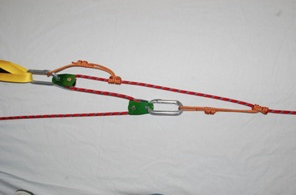Crevasse Rescue
Imagine a worst case scenario; you and your
friend are traveling up a glacier and white out conditions
arise. You cannot see more than fifteen feet in front of you
and you and your partner are roped up. All of a sudden the
rope goes tight as your partner falls into a crevasse. You
self arrest, build an anchor, and sit back to think about the
situation. There is no way of telling if your partner is
conscious, or even alive. There is no one for miles and no way
to get a rescue party until the storm clears. Luckily you are
a prepared alpinist and have a set of pulleys and stoppers,
but you only have two and it dawns on you that you may not be
strong enough to pull him out. Like any good physics student,
you pull out your calculator and begin jotting the problem
into the snow.
Below is an image of a very simple z-pulley used for crevasse rescue.

What is a Z-Pulley?
You assume that your partner is 75 kg and he has 25 kg of gear. If you have a two to one pulley system, assume that there is no friction in the system, and figure that your lightweight mountaineering rope has a negligible mass. So how much force will be required to pull your partner the fifteen feet up?
The calculation would go as follows:
Mass Total=100kg
Force Total=(100kg)(Fg)
=(100kg)(10 m/s2)
=1000 N in the downward direction
Since this would be a double pulley system, the forces would be divided evenly between three strands of rope. A simple calculation would yield about 333.3 N per strand. A person exerting 333.3 N is the equivalent of pulling about 33 Kg which would be around 73 pounds. This would definitely be doable, the only catch is that you would have to pull the rope three times as far.
Basically a z-pulley system redirects the forces acting on the pulleys making them counteract each other and make work much easier.
Below is an image of a very simple z-pulley used for crevasse rescue.

Image courtesy of advdesigns.com
What is a Z-Pulley?
You assume that your partner is 75 kg and he has 25 kg of gear. If you have a two to one pulley system, assume that there is no friction in the system, and figure that your lightweight mountaineering rope has a negligible mass. So how much force will be required to pull your partner the fifteen feet up?
The calculation would go as follows:
Mass Total=100kg
Force Total=(100kg)(Fg)
=(100kg)(10 m/s2)
=1000 N in the downward direction
Since this would be a double pulley system, the forces would be divided evenly between three strands of rope. A simple calculation would yield about 333.3 N per strand. A person exerting 333.3 N is the equivalent of pulling about 33 Kg which would be around 73 pounds. This would definitely be doable, the only catch is that you would have to pull the rope three times as far.
Basically a z-pulley system redirects the forces acting on the pulleys making them counteract each other and make work much easier.